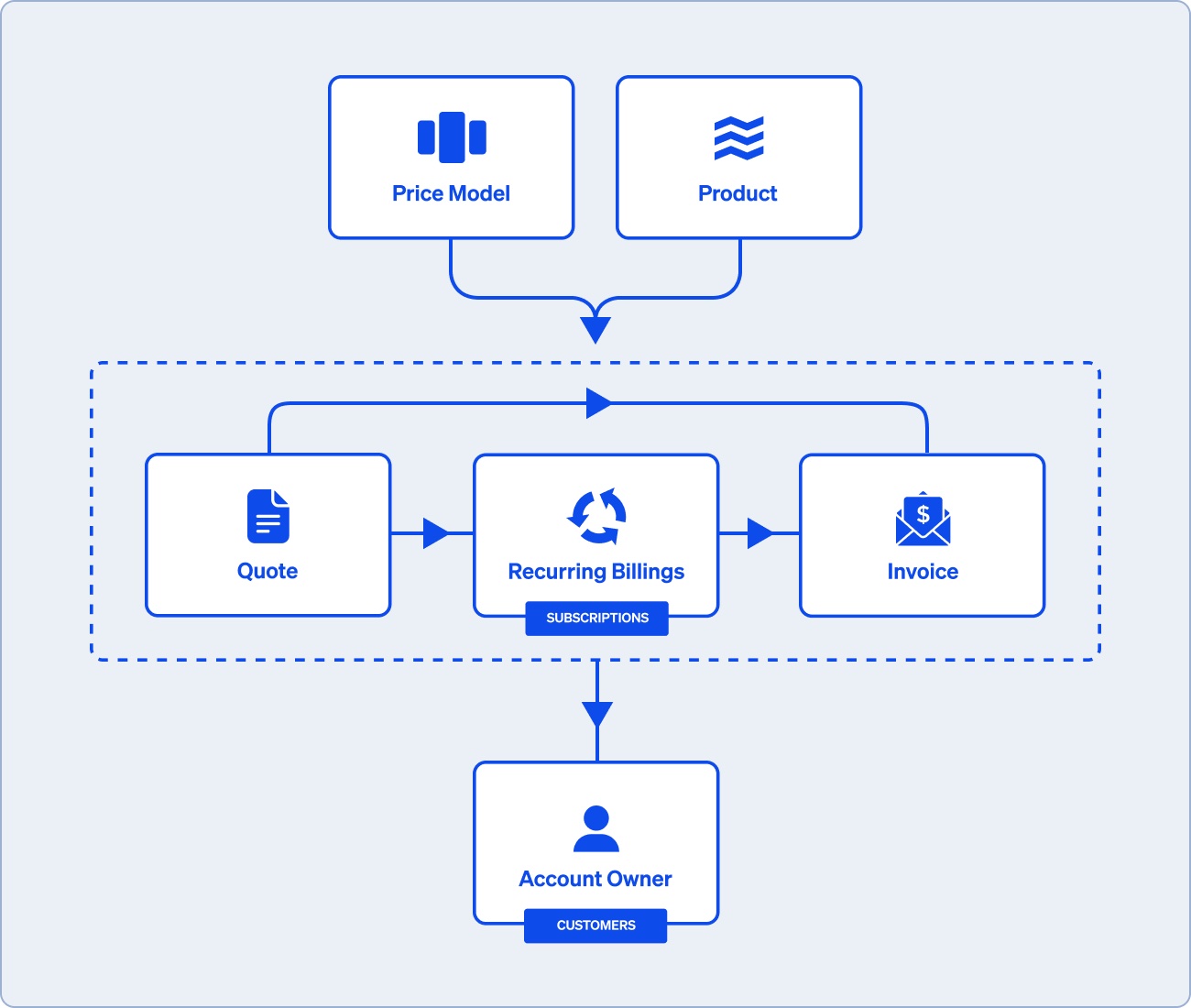This page is designed to explain the different components that make up Aqueduct's functionality.
If you want to get started with practical introduction, head over to the quick start guide.
Aqueduct handles billing and processes such as quoting, invoicing, and collections that depend on or feed into the billing logic. First you configure your billing logic in the Price Model, and then you can use it to create Quotes, kick off Subscriptions, or collect Invoices.

Billing logic
Price models: Most Aqueduct functionality starts with a Price Model. The Price Model allows you to quickly specify how you want to collect money by configuring 3 things:
- Price functions: How much to charge for something. For example, $25 per 10,000 API calls or $100 per hour of service. Multiple price functions can live in a price model.
- Billing frequency: How often to execute a pricing function. For example, one time, monthly, or annually.
- Billable events: Events that happen your product that you want to charge for in your price function. For example, if you charge $25 per 10,000 API calls, then you will want to send the number of API to the price model. Aqueduct aggregate the number of events on the billing frequency configured in the price model.
See Common business models to see examples of how a subscription business, metered business, or platform can represent their business model on Aqueduct.
Products
Product: What you’re selling. The product doesn't affect the any numerical calculations. It is used for displaying line items on invoices, calculating analytics, and managing provisioning state. Multiple prices can be used with the same product if you sell the same product at different price points.
Price model outputs
Invoices : Aqueduct creates invoices to collect payments for the amount owed as collected by the price model. Aqueduct sits on top of payment providers such as Stripe, Airwallex, and ACH.
Subscriptions: Subscriptions allow customers to make recurring payments. Price models with a recurring billing frequency will produce subscriptions. Subscriptions will create an invoice each billing period to collect any amounts owed.
Subscriptions, installments and recurring billings!
We support recurring billing all all its glorious variations. Request access from [email protected] if you want access to installment plans or recurring billings.
Subscriptions: Typically the customer prepays for access to the product and renews with no obligation to continue for subsequent billing period. Ex: Spotify, Netflix, NYtimes
Installment plans: A total amount that is paid over multiple periods. Differs from subscriptions in that customer is required to pay the full amount. Ex: Placing a deposit on a wedding venue for 25%, paying another 25% 3 months out, and the full remaining balance 2 weeks before the wedding.
Recurring billings: Recurring billing is a broad term that may include subscriptions but often used to refers to when the customer runs up a tab and is charged for good and services on a pre-arranged schedule. Usage based price models and professional services are often billed this way.
Quotes : Aqueduct allows you to provide your customer quotes based on a price model. Once a quote is accepted, it will become an invoice if the billing frequency is one time or a subscription if it has a recurring billing frequency. Creating a quote takes less than a minute on Aqueduct because quotes are associated with product models. This means you only need to input details specific to the customer such as their email. You don't need to reconstruct the shape of each deal by manually adding each line item one by one.
Accounts
Account Owner: Account owners represent an entity that can pay or receive funds via Aqueduct. Account owner corresponds to the concept of Customer on many other platforms such as Stripe.
Money Account: This is a balance associated with an Account Owner which represents amounts that the Account Owner owes or is owed.
Why "account owner" instead of "customer" or "account"?
Other system use the terms "customer" or "account" instead.
We use account owner to be able to precisely describe more nuanced scenarios. For example, when selling to a corporation, you may want to model out a customer hierarchy where multiple accounts roll up and are paid by a single entity. Or your business model may have an element of payouts where the term customer is not quite appropriate. For example, an on demand delivery platform have customers who pay for the deliveries and vendors who are paid for doing the deliveries.
